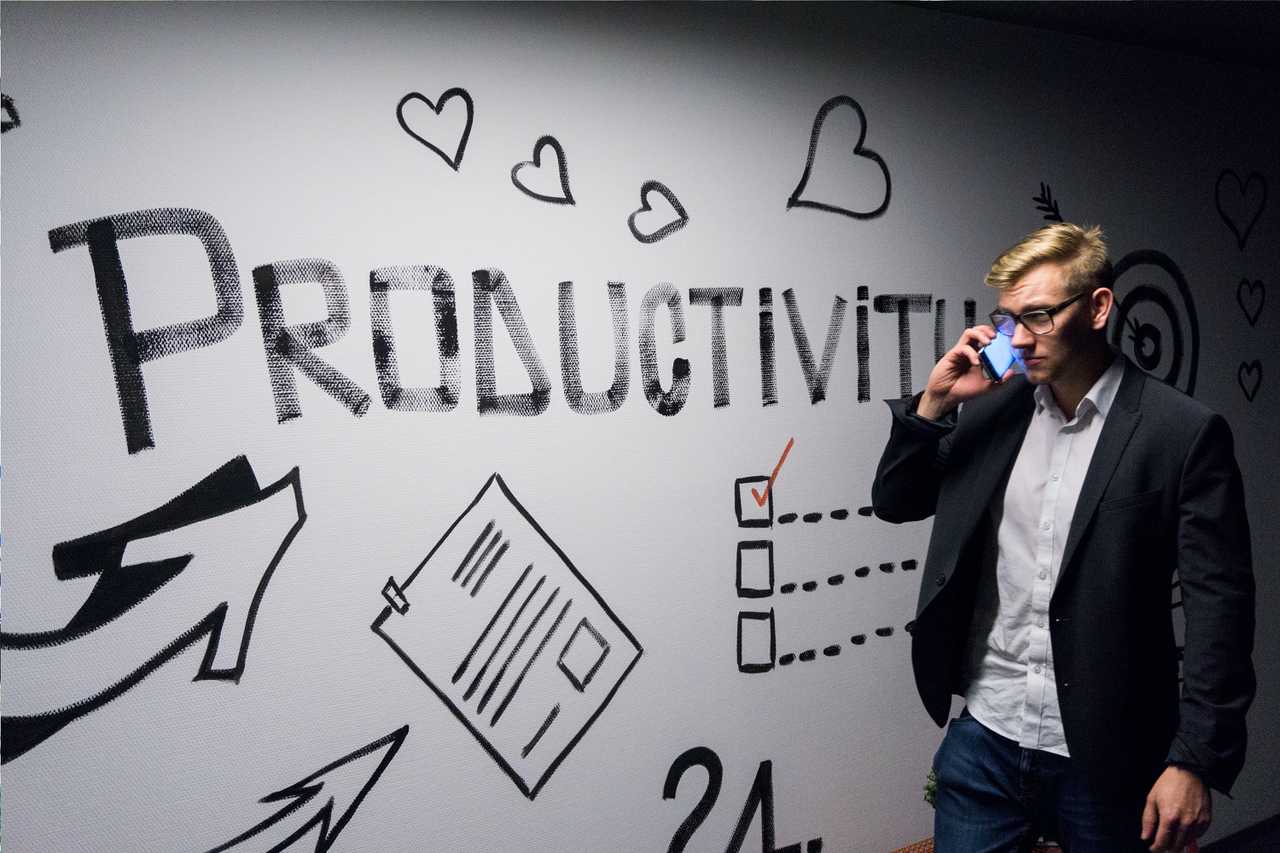7 must-know tips to improve Employee Productivity right now
16 min read by Bogdan Boța
published 6 years ago, updated 6 years ago
Home > Blog > 7 must-know tips to improve Employee Productivity right now
There is a lot of advice on the internet about improving your employee productivity. It appears that most people agree on some basic aspects, like delegate more, cut meetings and more training. These are very valid points, but, most likely, you've already implemented them if you are reading this.
In this article, we will get into more powerful and actionable points rooted in research and experience.
How to improve employee productivity
To increase the productivity of your employees, consider the following:
- Let them fail smartly
- Structure their work (for them)
- Your employees are the most important. Let them know!
- Don't keep them busy
- Give them higher stakes to work for
- Unite toward a common goal (or enemy)
- Help them focus on meaningful work!
Let us dive deeper into these points and see how they can be applied in your situation.
1. Let them fail smartly

Problem
My employees only do what's expected of them. Nobody tries something better.
Nobody likes to fail. It's in our nature to avoid bad outcome situations. Luck would have it, these situations are the ones you learn from the most. Unfortunately, it is not a straight forward process.
Learning from failure is a well-known concept, and it was tried by a lot of entrepreneurs with various success rates. Or so one would think. The problem occurs when you think about failure as a bad and undesired outcome! This is not a learning mindset, and it will not promote good results.
Amy C. Edmondson (the Novartis Professor of Leadership and Management at Harvard Business School) does a great job of explaining this phenomenon in her article Strategies for Learning from Failure, published in Harvard Business Review. To summarize, she explains the problem comes from the managers' conception that failure is bad. That the only way to learn failure is to reflect on what went wrong.
This could not be further away from the truth!
Edmondson goes on classifying 3 types of situations in which failure occurs: routine, complex, and frontier.
Routine failures are caused by employees who fail to follow a procedure. Imagine you just bought an IKEA mirror, assembled it, and hanged it on the wall. The next day when you come home, the mirror is shattered (thankfully nobody was hurt). This could've been a routine fail of the producer, meaning you got a faulty mirror. It could also have been a routine failure of yourself, not assembling it according to the instructions.
Complex failures are caused because of the sheer number of variables. These usually appear in very complex systems like airplanes. There are too many variables to account for, and effectively responding to those failures becomes a critical task.
Frontier failures are the ones we really want to happen, as they facilitate progress. Think of this as testing the waters. Trying a new fishing lure, knowing nobody tried it before and it might, very well, be useless. But what if it lures the tastiest fish ever?
Solution
Create a safe, controlled space, where you encourage frontier failures and learning.
Encourage people to take smart risks
Routine failures are usually to be avoided. Training, enforcing protocol and several similar solutions exist.
Complex failures usually resume at designing a system to handle them. Catch the small issues before they become full-blown problems. Analyze what caused them and implement preemptive measures.
Frontier failures should be encouraged. This is the way to beat the competition. Doing these experiments will provide you new market insights.
Here are some guidelines to learn from failure correctly:
- plan controlled experiments at the edge of your understanding. Try some new approaches and products, but not completely out of your expertise.
- let the pilots run in real conditions (not artificial, optimal ones). This means you should not test "if product X can work", but "why product X might fail".
- your products might fail or succeed, but it does not matter. Seek to learn what should be improved or avoided.
With this mindset in your head, you can now encourage employees to learn from failure. Have a training session to explain the concepts and make it clear the purpose is to learn.
In no time you will get reports telling you "strategy X is lacking Y", "product Z needs these changes" and so on.
2. Structure their work (for them)

Problem
Hectic schedules force people to multitask and they are not productive
Multitasking is one of the most common myths of the 21 century. In my professional life, I still encounter people telling me they can multitask. This worries me much, as there is a lot of research out there disproving this claim. Just searching "multitasking" in Google Academic gives you more than 150k related studies. They analyze multitasking in different scenarios and measure the costs on performance. Your read that correctly: the costs on performance, not the increase in performance.
An article published in 2006 in American Psychological Association reviews some of those studies. They explain the science behind multitasking (which is actually nothing more than task switching) and how they use the results from these studies. I will not go in further details, as they do a great job in this sense.
Solution
Allow people to have "do not disturb" windows
Encourage deep and focused work. Discourage multitasking.
Meet Lizzie. She's one of your valued employees in the accounting department. She works full time and you pay her 70k a year. You know answering emails is not exactly a productive part of her job, but it has to be done. You instructed her to do this "while" she does her usual tasks when she has a few minutes.
According to the American Psychological Association article, multitasking can decrease productive time by 40%. That would mean 3.2 hours per day or 28k a year. You pay Lizzie 28k a year to check emails. We all know this is a job that has to be done, but shouldn't it be cheaper?
This is so unexpected and we haven't even discussed the other, more worrying, consequence yet. Because of the constant context switching, the quality of her work suffers. As Rubinstein et al. and many more after them discovered, the error rate increases significantly when multitasking. Remember that Lizzie is one of your accountants, and mistakes are costly in this department!
Let's take a different approach.
Let's instruct Lizzie to check and respond to her emails in a 1h window. She will only read and respond to emails in that time, and ignore them the rest of the day. Don't worry, nobody will die if she responds tomorrow to some emails.
This hour a day of email checking is costing you only 8.75k a year. Without the increased error rate!
To summarize, instructing Lizzie to switch from "check emails when you have some free minutes" to "dedicate 1 hour a day for emails" saved you about 19k a year. And your accounting reports have fewer errors! I'd say that's quite a deal!
3. Your employees are the most important. Let them know!

Problem
People feel dispensable, and they are not giving their best.
I am certain you have employees who are OK at their job. They arrive just in time, leave on the clock and achieve just above the minimum expected from them.
On the other side, you may also have employees who always give their best. One might say that people are just different.
What if I told you that this is not always the case? Just imagine a world where all your employees are happily going the extra mile.
Solution
Schedule one-on-ones and tell people how their contribution is critical for the company.
You may be thinking: "I don't have that much time on my hands". Let's see why you might want to make this investment. Your company is doing well precisely because of your employees. You may be the one with the vision and guidance. You know what has to be done and when. This would be all meaningless without your precious employees to finely execute them.
Let's take Martin (one of your salespeople), for example. Remember what were Martin's contributions the past weeks. Say he contacted 20 companies, of which 3 agreed on a new contract with you. Now think where you would've been without Martin's help. Simply 3 contracts less and with 20 customers on your TODO list, locking away your precious time. Now go tell Martin how much he helped your company! Easy, right?
Indeed, you could tell me: "Well, he's been paid to do that. It's his job! Why all the extra work from my side?". I encourage you to look at this from a monetary point of view:
Say you pay Martin 60k a year, and he manages to acquire about 50 customers a year. This would mean a rough acquisition cost of 1.2k per customer. Each customer brings you a profit of 5k. Quite profitable!
When he's motivated, he can push that to 55 customers (resulting in 1k per customer). When he's not motivated, he will acquire about 45 customers (resulting in 1.3k per customer). Mind you, these are very conservatory numbers. I've seen situations where productivity doubled.
In order to help Martin feel he is an important part of your company, you will spend roughly 1h each month. This is a total of 12h a year. Assuming all goes well, you "won" 10 customers (50k) in 12h. The time you spent talking to Martin is valued just above 4.1k per hour! Take a moment to understand this. You have worked 12 hours at the incredible rate of 4.1k per hour! Now, this is a performance to brag about!
Not convinced?
In the same example, you value OK-Martin's time at 112.5 per hour (him bringing 45 customers per year). Happy-Martin is at 137.5 per hour with his 55 customers per year. This means you have spent 12 hours to increase his productivity by 22%!
And we are not even talking about all the other positive outcomes of having employees who feel valued, such as higher levels of commitment to the company.
4. Don't keep them busy

Problem
Everybody's calendar is 100% full, but you feel stuff is not moving along
This is one of the most common misconceptions in the modern business world. It is heavily discussed by the business management guru, Eliyahu M. Goldratt, in his famous book, The Goal. I highly recommend you read this business novel, as it can really help you understand what performance is and how to achieve it.
The basic idea is simple. Commonly, people are punished if they slack on the job. So if they can do something faster, they usually don't. This is because they would need to work more to fill the "free" time they earned.
Although this is already bad, it's gonna get worse. As your employees need to "fake" some work even when they need a break, they don't really rest in that time. Later on, they perceive that time as "work" and will be tired, accordingly.
So not only do they not work at their full potential, they also get tired because of it.
Solution
Measure WHAT your employees ACHIEVE, not how much they spend working
This one is really simple. Go tell everybody: "If you finish faster, go home".
In all seriousness, it's a little more complicated to implement correctly. The problem is dual-sided. On one hand, employees might understand this means less work, which will make management unhappy. On the other side, management might force too much work, because people have "free" time, which will make employees unhappy.
You will need to work together with your employees and find a balance. Try something along those lines:
- find how much your people achieve in a regular month. Not how much time they spend, but how much quantifiable results they produce.
- explain to them they should produce the same results.
- if they finish faster, let them rest. This means going home earlier or chilling at work, their choice.
- make sure you negotiate beforehand how you measure extra work and how it will be rewarded.
As Goldratt explains in his book, the key to this is to know what your goal is. You don't need people wasting 8 hours of their life daily. You want the results they produce when they are happy. Keeping this on the top of your head should make it easier to implement.
5. Give them higher stakes to work for

Problem
People don't come up with improvement ideas
The atmosphere in your company is quite still. Everybody arrives at 9, does their work, and, as soon as the clock strikes 5, they go home. Everything appears to be normal. There are no problems, but no advancements either. Your employees are doing what they are supposed to, but nothing more.
This is a very dangerous position for a company. Staying in this state means no improvements, no new ideas, no new nothing. Your income is stable now, but what if a shiny new product appears on the market? Are you ready to fight for your position?
Companies who are "taking it easy" because "it's ok now" are an easy target. The smart startups out there try to make a name for themselves by disruptive innovation. As soon as one of those disruptions resonates with the customers, all the other players are in big trouble. You have to adapt fast in those situations, or you lose a lot of revenue.
The business visionary, Simon Sinek, does a great job explaining how to stay on top of this. In The Infinite Game he presents the mindset needed to survive in this "race". If you think of the business world in terms of 'win the market', 'beat company X', 'be number one', I highly recommend this book.
Solution
Train people to play the infinite game
Create personal stakes
Establishing this mindset is only half the story. After you get people on board with the whole infinite game strategy, you might face a new issue. Although people know what to do and how to do it, they don't really want to.
This is where identifying with the company is really important.
Let's have a simple example in this case. You are having a beer with your friends and one of them wants to buy a new phone. This starts an argument, debating which phone is the best. You will, most likely, spend some time to convince them that your favorite one is the best, and they should buy it. Consider the effort you put into this, even though you wouldn't get any monetary reward if you made the sale.
Money is not the only driving factor. People that identify with a company want to see the company succeed as if it was their own. In a sense, it is their own company, it's just that they don't own it.
Organizational identification, the perception of oneness with or belongingness to an organization, is a wide subject to talk about, and will not fit in here. The bottom line is that you want an environment in which people proudly say "my company".
6. Unite toward a common goal (or enemy)

Problem
Nobody is feeling part of a real team
As the saying goes, "United we stand, divided we fall". This is the reason we have companies in the first place.
100 people working in a car factory will achieve a lot more than 100 individual people making cars on their own. The simplest way to prove this is to think about the equipment needed. The car factory needs to buy this equipment, and the workers share it. In the individual people scenario, each of them has to buy their equipment. This was all obvious to you, of course, but this is just the tip of the iceberg.
If you and your employees are not working as a team, you're missing on a lot of revenue.
Solution
Convey towards a common goal (or defeating a common enemy)
One of the essential ways to have your employees become a team is having them work towards a common goal. Consider playing some team sport, like football. For the duration of that game, you don't care about personal differences, you work together to win.
An even better way to achieve this is to declare a common enemy. I'm gonna use a more radical example here: an economic crisis. People form closer bonds in this time, by having faced this fear of unemployment and poverty together. They help each other find and keep jobs, they share more material goods in their social circles, and so on. Their common enemy is "these times that are endangering our comfortable lives". They end up forming a stronger bond because of the nature of the situation and the fact they overcame this together.
Unfortunately, this is not the end of the story. A lot of people do lose jobs and their homes. Others might be forced to give up their comfortable lifestyle altogether.
I made such a controversial point with the common enemy to emphasize the danger of this method. It's really powerful, but it can have devastating effects on the people, so a lot of consideration is required.
In the business world, there are some milder alternatives, like "we plan to overcome company X". This kind of thinking can help people bond, by putting them "in the same bucket". Whenever there is (an opposing) "they", the "us" identity becomes stronger. When somebody asks: "What are you doing?"; they will respond with "Overcoming company X". Since all of them work towards the same goal, they just created a team. The team that "overcomes company X".
This can be the beginning of very lucrative relationships. The next step here is a good company culture, which we're gonna talk about in another post.
7. Help them focus on meaningful work!

Problem
Employees are demotivated because they have to do "the boring part"
Every job has boring parts. This could be filling paperwork, responding to emails, attending meetings, and so on. Basically everything that is repetitive, and you appreciate that someone less experienced than you can do.
On the first day on the job, you don't mind responding to a few emails. After your 1000th email, it is another story. You cannot wait to get that done and do something interesting.
One would argue that these are essential parts of the job and cannot be skipped. Is that really true? What if all of this could be automated, and your employees could use that time to do the "real work" they were hired to do?
Solution
Eliminate meaningless work
The argument goes like this: if it's repetitive and predictable, computers can do it. In this day and age, we have custom software that can take care of almost everything.
Depending on your needs, there are various solutions which you could implement. Read more about solutions we tested in our going digital guide.
I'm gonna use a real example here, Inox Line Distribution (see testimonial), a company specialized in professional kitchen equipment retail. Before, they needed between a few hours and a few days to create a price quotation, depending on the number of products. One would have to search for the products, verify prices and availability, confirm with the client if a change occurred, and so on. Those were done in an offline document editor, meaning only one person could work on it. In order to share those documents, emails and USB thumb drives were used.
To improve this, they now use the following approach:
- create a shared database of products and clients. No more searching through paper or PDF catalogs.
- have all the generated quotations (they call them offers) in the same place. Everybody can quickly search through them, no lost files.
- move everything online. No more mails, or complicated computer set-ups. Click a link and done.
- create a stylish template. No more fiddling with how the resulted document looks. Just select the products you want, the client you sell to and click 'Print'. Everything looks nice, and you send the price quotation to your customer.
With this simplified process, they managed to drastically reduce the hours needed to create the offers. This means they reduced the time from talking to the client to offering them a quotation to minutes. What was before hours or even days, is now almost instant.
This lead to a drastic increase in closed sales, and, obviously, profit. They were able to triple their revenue and establish a strong position in their local market.
All of this was done with OptiOffer! Read more about this, below.
Conclusion
We have analyzed 7 reasons your employees may not be productive and provided ready to implement solutions:
Create a safe, controlled space, where you encourage frontier failures and learning.
Encourage people to take smart risks
Allow people to have "do not disturb" windows
Encourage deep and focused work. Discourage multitasking.
Schedule one-on-ones and tell people how their contribution is critical for the company.
Measure WHAT your employees ACHIEVE, not how much they spend working
Train people to play the infinite game
Create personal stakes
Convey towards a common goal (or defeating a common enemy)
Eliminate meaningless work
Your situation is unique, and you have to decide which of those you want to implement.
In my experience, the most common problem is 4. Employees being busy, but not productive.
The simplest to fix is 7. Let them do meaningful work!.
